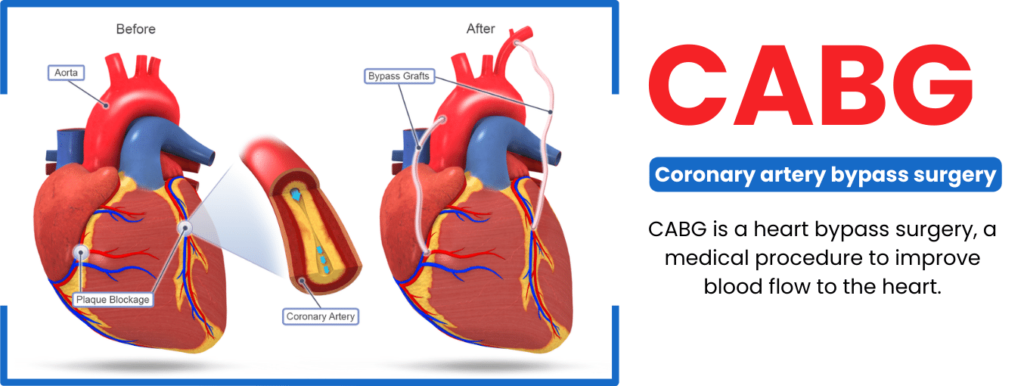Coronary Artery Bypass Surgery: A Lifesaving Intervention

Coronary artery disease (CAD): is one of the leading causes of mortality globally, posing a significant threat to millions of lives. When arteries become blocked or narrowed by plaque, the heart’s blood supply is compromised, leading to serious complications, including heart attacks. For severe cases of CAD, coronary artery bypass surgery (CABG) offers a lifesaving solution. As an experienced cardiac surgeon specializing in Cardiothoracic and Vascular Surgery (CTVS), I have dedicated my career to performing CABG and transforming the lives of patients with advanced heart disease.
Understanding Coronary Artery Disease
Coronary artery disease occurs when the coronary arteries, which supply oxygen-rich blood to the heart, become obstructed by plaque—a mixture of cholesterol, fatty substances, calcium, and other materials. This buildup narrows the arteries, reducing blood flow to the heart muscle. Symptoms of CAD include chest pain (angina), shortness of breath, and in severe cases, heart attacks. While lifestyle changes and medications can manage early stages of CAD, advanced cases often require surgical intervention.
The Role of Coronary Artery Bypass Surgery
Coronary artery bypass surgery is a surgical procedure designed to restore normal blood flow to the heart by bypassing blocked or narrowed coronary arteries. This is achieved by grafting a healthy blood vessel from another part of the body, such as the leg (saphenous vein) or the chest wall (internal mammary artery), onto the coronary artery beyond the blockage. This new route allows blood to flow freely to the heart muscle, alleviating symptoms and significantly reducing the risk of heart attacks.
The CABG Procedure: Precision and Expertise
Performing CABG requires a high level of skill, precision, and understanding of cardiac anatomy. The procedure begins with the harvesting of the graft vessel. Next, the heart is temporarily stopped and a heart-lung machine takes over the function of circulating blood and oxygen. The surgeon then attaches the graft vessel to the coronary artery, bypassing the blocked section. Once all grafts are in place, the heart is restarted, and normal blood flow is restored.
Throughout the procedure, meticulous attention to detail is crucial. From graft selection to the precise suturing of vessels, each step must be performed with accuracy to ensure the success of the surgery and the long-term patency of the grafts.
Benefits of CABG: Beyond Symptom Relief
While the primary aim of CABG is to alleviate symptoms and improve quality of life, the benefits extend far beyond. CABG can significantly reduce the risk of future cardiac events, including heart attacks and sudden cardiac death. For patients with complex coronary anatomy or multi-vessel disease, CABG offers superior long-term outcomes compared to other interventions like percutaneous coronary interventions (PCI).
Personalized Care: A Cornerstone of Our Approach
At the heart of our practice is a commitment to personalized, patient-centered care. Each treatment plan is tailored to meet the unique needs and preferences of the individual patient. From the initial consultation through postoperative care, we provide comprehensive support and guidance to ensure the best possible outcomes. Our team is dedicated to making the surgical experience as comfortable and stress-free as possible.
Choosing Excellence in Cardiovascular Care
In the field of cardiac surgery, excellence is non-negotiable. We are committed to delivering the highest standards of care, continually refining our techniques and staying abreast of the latest advancements in cardiothoracic surgery. By choosing CABG with us, patients can be confident that they are receiving top-tier care from a team of highly skilled professionals dedicated to their health and well-being.
Conclusion: A New Lease on Life
Coronary artery bypass surgery remains a cornerstone in the management of advanced coronary artery disease, offering hope and a new lease on life to countless individuals worldwide. With our unwavering dedication to excellence and a patient-centered approach, we stand ready to guide patients through every stage of their journey towards optimal cardiovascular health. For those facing the challenges of severe coronary artery disease, CABG provides not just relief, but a pathway to a healthier, more fulfilling life. Trust your heart to our expertise and experience the difference of truly personalized cardiovascular care.
Frequently Asked Questions (FAQs): 👇
CABG is a surgical procedure that improves blood flow to the heart by bypassing blocked or narrowed coronary arteries using grafts from other parts of the body.
The surgery typically takes 3 to 6 hours, depending on the number of bypasses needed and the patient’s overall health.
Recovery time varies but generally takes 6 to 12 weeks. Patients often start with a hospital stay of about 5 to 7 days, followed by a gradual return to normal activities.
Like any major surgery, CABG carries risks, including infection, bleeding, heart attack, stroke, and complications from anesthesia. However, it is a common and generally safe procedure with a high success rate.
Preparation includes preoperative tests, adjusting medications, and possibly lifestyle changes such as quitting smoking. Your healthcare team will provide detailed instructions tailored to your specific needs.
Post-surgery, adopting a heart-healthy lifestyle is crucial. This includes a balanced diet, regular exercise, quitting smoking, managing stress, and adhering to follow-up care and medications prescribed by your doctor.
